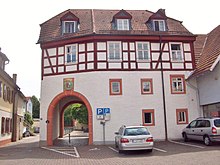Grinding rashof
The Schleifrashof , named after the last noble owner, is a late medieval aristocratic residence from the 15th century with a later castle-like mansion in the Salmünster district of the city of Bad Soden-Salmünster in the Main-Kinzig district in Hesse .
location
The former aristocratic seat is located south of the old Salmünster on the corner of Frankfurter Strasse and Hirtengasse in the former area of the city wall .
history
The exact time of construction is unknown. The main building (known as the Winkelbau ) with stair tower and ancillary building as well as the bower date from the 15th century. Until 1540 the property was owned by the von Hutten family and was documented as Huttenburg . In that year the Electorate of Mainz acquired the Herrenhof. Mainz gave the court in 1564 as a fiefdom to the von Breidenbach called Breidenstein . In 1650 the Adelshof passed to von Fechenbach by marriage . Gottfried von Fechenbach sold his property in 1706 to Martin Ludwig von Schleifras zu Reichlos and his wife Magdalena Elisabeth von Bicken . In 1707 they had the gate with the wedding and double coats of arms built by von Schleifras and von Bicken . In 1768 the farm was sold to the Fulda monastery . From this the yard was used as a Latin school. With the secularization around 1805, the grinding rashof became state property and set up as the seat of the chief forester's office.
Todays use
Today the Schleifrashof is owned by the city of Bad Soden-Salmünster. During the renovation of the old town, it was prepared for about two million Deutschmarks for community purposes. The courtyard now houses a wedding room and is used for community events. There are private apartments and a kindergarten in the complex. Since March 2014 it has been checked whether the farm could be used and expanded as a club and youth center. Opposite the former aristocratic residence is the Salmünster local history museum .
description
The Schleifrashof is an almost completely preserved rectangular courtyard from the late Middle Ages (aristocratic seat) with the character of a castle . The buildings around the stair tower with Welscher hood have ground floors made of masonry, the two upper floors are each designed as a half-timbered structure . The gate construction is also worth seeing.
Web links
- Entry on Bad Soden-Salmünster (Schleifrashof) in the private database "Alle Burgen".
- Image of the grinding rashyard
- Old building with tower
- Attractions . City of Bad Soden-Salmünster
Individual evidence
- ↑ in Jäger: Fürstentum Fulda, p. 396: A Kemenate "Huttenburg", the later grinding rashof, as well as additional goods acquired in 1564 those von Breidenbach called von Breidenstein . Cf. also The knight nobles von Hutten, their social position in church and state up to the end of the Old Kingdom, footnote no.545, p. 76
- ^ Wedding hall Schleifrashof Salmünster with pictures
- ↑ www.fuldaerzeitung.de: Debate about Schleifrashof as a meeting place
literature
- Rolf Müller (Ed.): Palaces, castles, old walls. Published by the Hessendienst der Staatskanzlei, Wiesbaden 1990, ISBN 3-89214-017-0 , p. 34 f.
- Author collective: Salmünster. From the past of an old town in the Kinzig valley. Festive edition on the occasion of the 650th anniversary of the city's renunciation, o. O. 1970.
- Georg-Wilhelm Hanna : Castles and palaces in the Kinzig valley . Publisher Hanauer Anzeiger, Hanau 1992.
- Heinrich Hofmann: About the Schleifrashof and its residents . Ed .: City administration Bad Soden-Salmünster, 1991, 48 pp.
Coordinates: 50 ° 16 ′ 30.1 ″ N , 9 ° 22 ′ 3.6 ″ E



